- Hello - Namaste
- Goodbye - Alavidha
- Good morning - Shubha prabhaat
- Good night - Shubha raatri
- Thank you - Dhanyavaad
- You are welcome - Aapakaa svaagat hai
- Please - Kripyaa
- Excuse me - Shamma kare
- Yes - Ha
- No - Nahi
- I do not understand - Mai nahii samajhataa hu
- Do you speak... - Kyaa aap... ?
- English - Angrejii
- What is your name? - Aapka naam kya hai?
- Nice to meet you - Aapse milkar khushii huyii
- How are you?- Aap kaise hai?
- Good - Achchhey
Level of surfing
Competent
Quality of surf
Good
Call code
91
Net code
in
Area
3287590
Coastline
7,000 km
Climate
Varies from tropical monsoon in south to temperate in north
Hazards
Extreme Heat, Difficult Access
Best Months
June - August
Population
1120000000
Currency
Indian Rupee (INR) Indian rupees per US dollar - 45.3 (2006),
Time Zone
Indian Standard Time (UTC+5.30)
Special Requirements
Strict Religious Observance
introduction

João Felipe C.S: Location India; May 12, 2008
India (the Republic of India) is the 7th largest country by geographical area and the second most populous country in the world, located in South Asia. It has a coasline of 7,517 kilometers and is bounded by the Bay of Bengal on the east, the Arabian SeaIndian Ocean on the south. It borders Bangladesh and Burma to the east; Pakistan to the west; and China, Nepal, and Bhutan to the north-east.The capital city of India is New Delhi and the largest city is Mumbai. Official languages in India are Hindi and English.
history
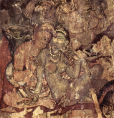
Indischer Maler des 6. Jahrhunderts: Liebespaar; 6. Jh. (6th century)
The history of India goes back almost six thousand years and has passed through many different stages and societies and invasions from outside. The earliest civilization was in the Indus Valley (now in Pakistan), with its well-planned city-states of Harappa and Mohenjo-daro, which lasted from 3250 to 1500 B.C. Mohenjo-daro probably had a population of 35-50,000, which was very large by the standards of the ancient world.
After the collapse of the Indus Valley civilisation a new wave of people entered India - the Aryans (a semi-nomadic race of pastoralists) came from central Asia. The Hindu religion also evolved at this time and the sacred literature called The Vedas was created.
In 567 B.C. Gautama Buddha was born, who was the founder of the Budhist religion. Also at around this time Mahavira lived, who started the Jain religion.
In the 4th century B.C. Emperor Ashoka (one of the greatest leaders in the history of India) led the Mauryan Empire to take over almost all of what is now modern India.
In the south part of India several different Hindu empires (the Cholas, the Pandyas and the Cheras) spread and grew, trading with Europe and other parts of Asia till the end of the 1100s. Christianity came to India at about the same time as it came to Europe. But even earlier than that people of the Jewish religion settled on India's shores.
In approximately the 7th century A.D. a group of Zoroastrians (or Parsees) came to the country and became part of the large mix of religions in India today. In the 15th century the Sikh religion was born in northern India. Each of those religions adds its important and distinctive flavour to the spiritual life of this great country.
In 1192 several places in the north of India including Delhi, were captured by Mohammed of Ghori,a ruler from Afghanistan. After he left the country, one of his generals in charge became the first Sultan of Delhi. And was during this time when Islam (the Muslim religion) was introduced into India.
200 years later Timur ("Timur the Lame" or "Tamberlane") came from Turkey to attack India. Many valuables twere stolen and after that the Delhi Sultanate was never so strong again. Soon after that the Moghuls came from Iran and took control in the north. But during that time in the south the Hindu Vijayanagar Impire was set up and became very strongy strong.
The Europeans (Portuguese, French, Dutch, Danish and British) started arriving in the early 1600s. All of them held territories in India, but it was the British who eventually controlled most of India and finally made it one of their colonies.India earned its Independance from the British in 1947 after a long struggle, led mostly by Mahatma Gandhi. Since than India has made huge progress: the country has developed its industry and agriculture, and has maintained a system of government which makes it the largest democracy in the world.
surfing
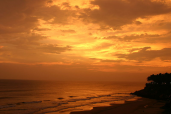
Saravask: Sunset on Varkala Beach, Kerala; 2006
Ever since the Australian Cricket Team started bringing their boards with them on tour here, surfing has been on the rise. both the east and west coasts of India experience surf. Some of the coastal communities have extreme population concentrations and so water quality can be a concern around these areas.
The Andaman and Nicobar Islands just to the north of the Mentawi's may well be one of the best kept surfing secrets in the world. It is expected that travel will continue to become cheaper to this remote chain, there may well be another Nias just hiding behind the last point that no one has bothered to check out so far.
Storm cells rip through the Arabian Sea around May through to July and deliver good swell right along the western coast. Oct - Nov sees storm front activity in the Bay of Bengal that provides rideable options on the east coast. It is worth bearing in mind that there are fewer than 50 surfers living in India so it's one of those places that you dont mind surfing with someone else for a change. The predominat flow of SW swell across the Indian Ocean tends to miss the coast with Sri Lanka really being the cut off point for reliable swell activity originating in the Southern Hemisphere.
Wandering swell systems can and do manage to get bent back to the coastline here however offering you another source of swell generating activity. Be sure to enjoy the isolation while it lasts, before someone builds a surf camp there.travel
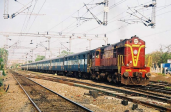
Ravikiran r: Indian train; 27 December 2005
Citizents of most countries will need visa to get in. Ask for a multiple entry visa even if you aren't planning to use it, as they cost the same, are issued pretty liberally and come in handy if you suddenly decide to visit one of the neighboring countries.
Unfortunately railway system is not as reliable as it could be, so many tourists prefer to travel by bus or plane. Bus services are available from Nepal, Pakistan, Bhutan and Bangladesh.Note taht it might be cheaper to take one bus to the border crossing and another from there on. If you travel from Nepal, you will usually find connections to New Delhi, Lucknow, and Varanasi. The Royal Bhutanese Government runs a service to/from Phuentsholing. These buses are comfortable, but note that the journey will take around 18 hours and the condition of the highway is not the best. From Pakistan the only land crossing is from Lahore to Amritsar, both quite close to the border (about 30-40 minutes drive), so catching a taxi may be a better option. The journey from Bangladesh would probably be the easiest one. There are regular air-conditioned and comfortable bus services from Dhaka to Kolkata via Haridaspur (India)/Benapole (Bangladesh) border post.
India has several international ports on its peninsula with Mumbai and Chennai being the main ones handling passenger traffic.If you decide to travel by plane, you will probably land in Mumbai, New Delhi, Chennai or Kolkata, though many other airports are also taking in international flights (such as Jaipur, Cochin, Mangalore, Amritsar, Bangalore, Ahmedabad, Calicut, Guwahati and many others).
where to stay
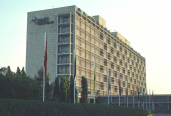
Lokantha: Oberoi Hotel, Delhi; 30 October 2007
There are numerous options in India: for every budget and every taste. In big cities you will find many cheap travellers' hotels where you can find a room for less than $10. You can spend even less money if you stay in dormitories (around $1). Just make sure you always check the safety and cleanliness of the places you are staying in. Remember about malaria in certain areas, so choose places with air conditioning and sealed windows.
Looking for something more comfortable? No problems! There are many midrange hotels in the larger cities. Be prepared to pay around $50-$100. There are some very popular chains, such as Counry Inn. You van also stay at resorts at Off-the-Beaten-Track locations (check Neemrana). If you want something more exciting (and you can afford it) then stay in former maharaja's residence in Udaipur. Plus there are many five-star hotels all over the country: Marriott, Hyatt, Sheraton India, Oberoi and Taj. You will not be dissapointed!
what to pack

Daniel Lobo: A soccer ball that is "thermally bonded"; 26 June, 2006
It shouldn’t be a question for anybody – of course something against
rain and cold even if you go in summer. If you’re taking a tent, check
whether its waterproof first and same applies to almost all the gear
you’re taking with you (eg. water-resistant bag pack and boots).
Nothing special required as pretty much everything you can by there.
A wheeled bag is usually the best unless you're backpacking, the
distances you have to carry your luggage at some of the train stations
and airports can be quite far.
Remember to take a voltage adapter that has the different plugs with it.
…Nearly forgot! Waterproof camera bag! You don’t want to lose all your pictures, do you?..
dangers and warnings

Patho: Rabies Virus EM PHIL 1876; 30 May 2006
India is usually safe for tourists, but expect some cultural shock wen you forst arrive. Streets are crowded, noisy and full of different smells. Locals will stare at you, so wearing local clothes will help if you want less attention. Be prepared to the dirt, garbage and insects that are cpmmon in teh cities. Pollution is a serious issue in teh country.
Theft is quite common in places visited by tourists, but violent thefts hardly ever occur. Anyway, it is better not to walk at night and not to expose your expensive posessions during the day. Keep an eye on your money and check whether the change you received is correct.
Be careful with spicy food if you are used to it and don drink tap water. No vaccinations are required for entry to India, but hepatitis (both A and B), meningitis and typhoid shots are recommended, as well as a booster shot for tetanus. Diarrhea is common, so make sure you have all basic medication with you.
India has the HIGHEST rate of Rabies in the world, so remember to STAY AWAY from the numerous stray cats and dog. Another extremely important thing - getting vaccinations and blood transfusions in India increases your risk of contracting HIV/AIDS-even in many private hospitals. And If you need to visit a hospital in India, avoid small government hospitals.
restaurants, shopping and nightlife
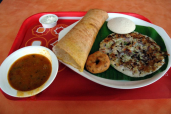
Jpatokal: South Indian thali at Haldiram's, Gurgaon; 16 December 2006
The Indian rupee is not officially convertible and rates for exchanging rupees overseas are often poor. There are many foreign exchange conversion units outside airports. The most common are Western Union and Thomas Cook.There are ATMs in the big cities, where you can use your international debit or credit card to get rupees. Citibank and HSBC both have a significant presence in India. But remember that SBI (State Bank of India) ATMs usually don't accept foreign cards. The good thing about shopping in India is that it is very cheap, but the trick is - you can either spend very little money ($4-$5 per day) or lots of money (five-star hotels charge rediculous prices!). If you like negotiating, than India is for you, because that is what street hawkers would expect you to do. Just remember, that department stores is another story.
Indian cuisine is amazing and is considered to be one of the best in the world. Indian food is spicy, so take it easy and start with the less spicy meals - you will get use to it. Food in India varies greatly from region to region: North India is wheat growing land; South India, in contrast, uses fewer spices and the food is mostly rice-based; West India will welcome you with Gujarati cuisine (mostly vegetarian and sweet, that makes heavy use of milk products), Maharashtra and Goa (famous for their seafood); and East India is famous for its Bengali food, that makes heavy use of rice and freshwater fish.
Looking for a good nightlife? Go to Goa, a state that is on holiday all the year through, where tourism is a major source of income and a lot credit goes to the nightlife.Ever since the times of hippies, partying has come to be an integral part of the state. The laws are liberal with alcohol, you can get a drink almost at any spot in Goa. However, it comes strict against drunken driving, nudity and drugs.
what to do when itś flat
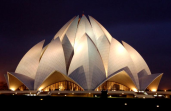
Indianhilbilly: Bahá'í Lotus Temple in South Delhi; 29 December 2007
India's culture is remarkable. Indian architecture is one area that represents the diversity of Indian culture and it would be a shame to miss such notable monuments as the Taj Mahal and other examples of Mughal architecture and South Indian architecture.
Plan to visit diferent cities as there is much to see: a statue of Shiva, a principle deity of Hinduism, in Bangalore; Ganesh Chaturthi, a popular festival in Mumbai; Bahá'í Lotus Temple in South Delhi and many more.
India also displays significant biodiversity. The red panda is found in the Himalayan foothills, which extend through Northeast India.
useful phrase guide
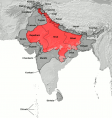
Dbachmann: Area where "Hindi languages" are spoken natively; 20 January 2008






